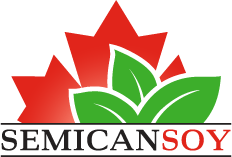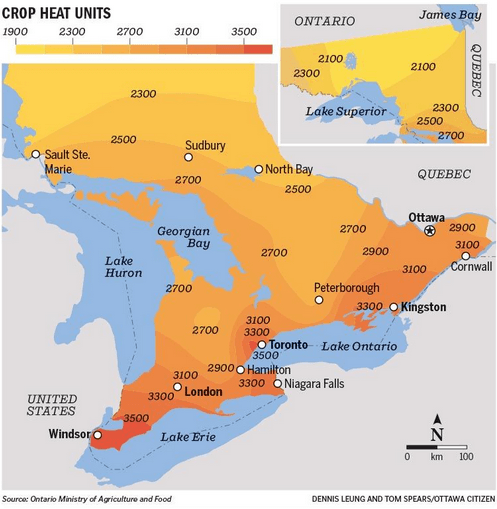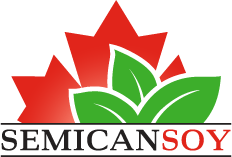TECHNICAL INFORMATIONS
Best practices for producing quality soybeans
Fact sheet:
The soybean is a herbaceous plant belonging to the Fabaceae family and the genus Glycine. Its scientific name is Glycine max.
Its height is between 0.50 and 1.50 m depending on the variety and growing conditions.
The soybean plant has trifoliate leaves and small flowers, purple or white in colour.
The fruits are pods 3 to 8 cm long, which contain the edible seeds, which are yellow in color.
The plant has a taproot with a lateral root system.
Soybean varieties are classified into maturity groups (GM) based on their response to the photoperiod.
Soybeans are annual, self-pollinating plants with determinate or indeterminate growth. Most pubescences are grey,
light brown, brown or dark brown.
- Stage VE
= Emergence of the seed.
- Stage VC = Appearance of unifoliate leaves.
- Stage V1 = First node.
- Stage V2 = Second node - The first trifoliate leaf is developed.
- Stage Vn/V3 = 2nd node / 3rd node.
- Stage R1 = Beginning of flowering.
- Stage R3 = First pods - A pod is 5 mm long on one of the 4 uppermost nodes of the main stem.
- Stage R5 = First Seeds - A seed measures 3 mm in one of the pods carried by one of the 4 highest nodes on the main stem.
- Stage R6 = A pod contains a green seed which fills the cavity on one of the 4 uppermost nodes of the main stem.
- Stage R7 = First ripe pod - A pod containing at least one seed on the main stem has reached its color of maturity
(brown-beige). The seed becomes rounded in the pod.
- Stage R8 = Maturity 95% of pods are at R7.
Source: http://blog.agriconomie.com
Thermal units
Inoculation
Inoculants are applied on the farm at planting time. But in recent years, growers have preferred “pre-inoculated” seeds.
Pre-inoculants are formulated to allow bacteria to survive on seeds for a long period of time before planting and are compatible with many fungicide treatments.
The advantages of certified seed
Certified seed complies with the Canadian Seeds Act. They are packaged according to rigorous production standards for greater varietal quality and purity. In some cases, certified seed allows you to negociate lower crop insurance premiums.
Choice of variety
Early varieties of SemicanSoy
Tofu type:
Mozart
(technical sheet): very early 2475
Tofu type:
Delance
(technical sheet): early 2500
Tofu type:
Daiki
(technical sheet): early 2525
Very high protein type:
Lustar
(technical sheet): early 2525
Tofu type:
Kazart
(technical sheet): early 2550
Late varieties of SemicanSoy
Tofu type:
Algar
(technical sheet): 2800
Tofu type:
Baltazar
(technical sheet): 2875
Sowing date
The choice of the sowing date
is very important for a good optimization of the yield. Before sowing soybeans, check:
- the calendar date;
- the condition of the seedbed;
- weather forecasts for the two days following sowing.
The effects of planting dates on yield are influenced by:
- the growing season;
- and the cultivar maturity group.
Soybeans are more sensitive to soil temperature than corn.
However, in general, you have to wait for a soil temperature of around 10 degrees centigrade.
When planting is delayed, soybeans take fewer days to mature;
in general, if sowing is delayed by three days, maturity is delayed by one day.
To improve vegetative growth in late seedlings, choose cultivars that reach taller heights and sow them in close rows.
Add at least 10% to the seeding rate to increase low pod height and number of pods per acre.
The harvest
For all our varieties, the necessary
arrangements must be made to avoid loss of quality.
The main causes of quality loss are:
- Discolouration caused by weeds, immature seeds and dust
- mechanical damage
Before harvest:
- Clean the threshing machine, trailers and silos to avoid contamination.
- Check fields , for example for volunteer corn plants.
At harvest:
- Check your soybean production contract in order to respect the quality guidelines at the time of harvest;
- The optimum situation to start harvesting when the grain moisture is between 14 and 16%. Grains at this humidity are generally round; which contributes to a quality harvest. Below 12% the risk of a high percentage of broken kernels increases, it is necessary to thresh more carefully.
- The forward speed of the threshing machine must be maintained so as to have a good supply of the entire threshing system, generally between 4 and 6 km/h;
- Lower the cutter bar as close to the ground as possible;
- Reduce the space between the reel and the cutter bar.
- The speed of the reel must be 10 to 25% faster than the forward speed of the thresher.
- Reduce the opening size of the upper grid, screen according to the size of the grain.
- If you notice grains with a cracked husk, tighten the concave and/or decrease the speed of the mixer.
- Avoid threshing soybeans when soybean plants are wet; you must wait until they are dry before starting.
- Check and clean the table, conveyor inlet and rock trap often for accumulated soil to prevent soybeans from being stained.










